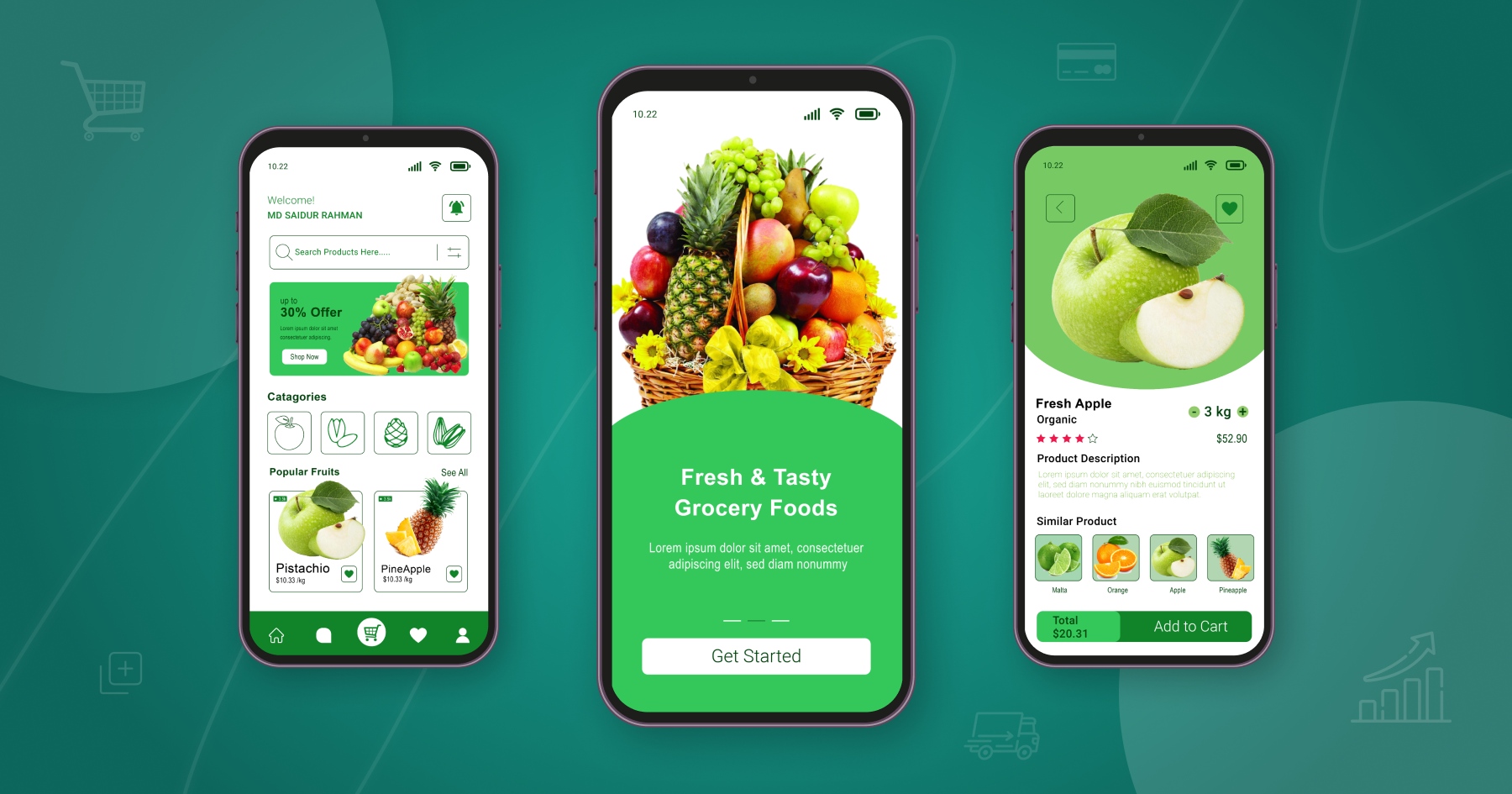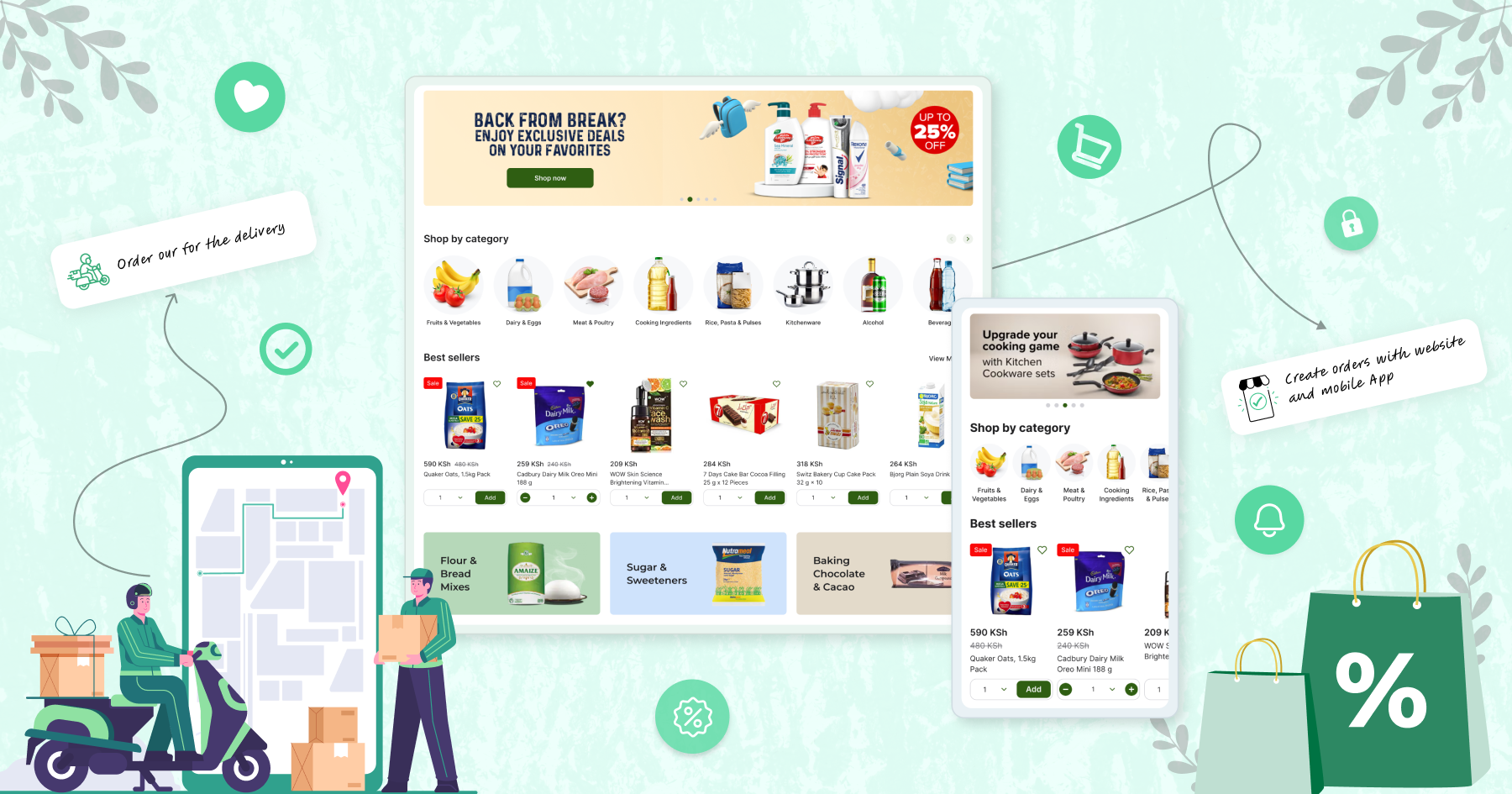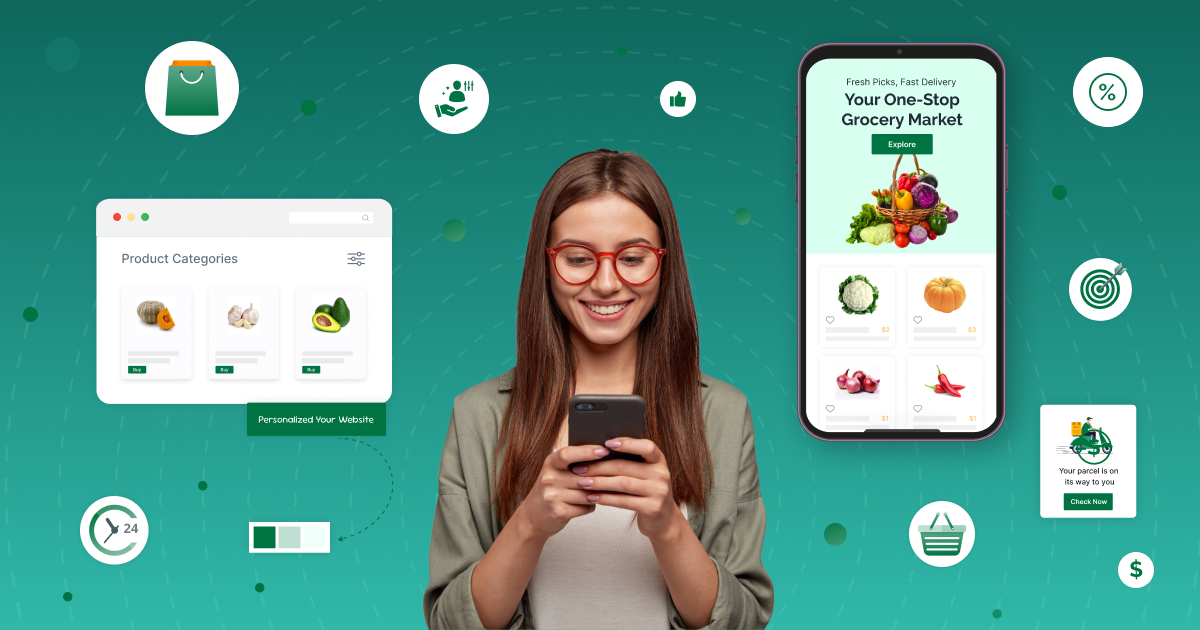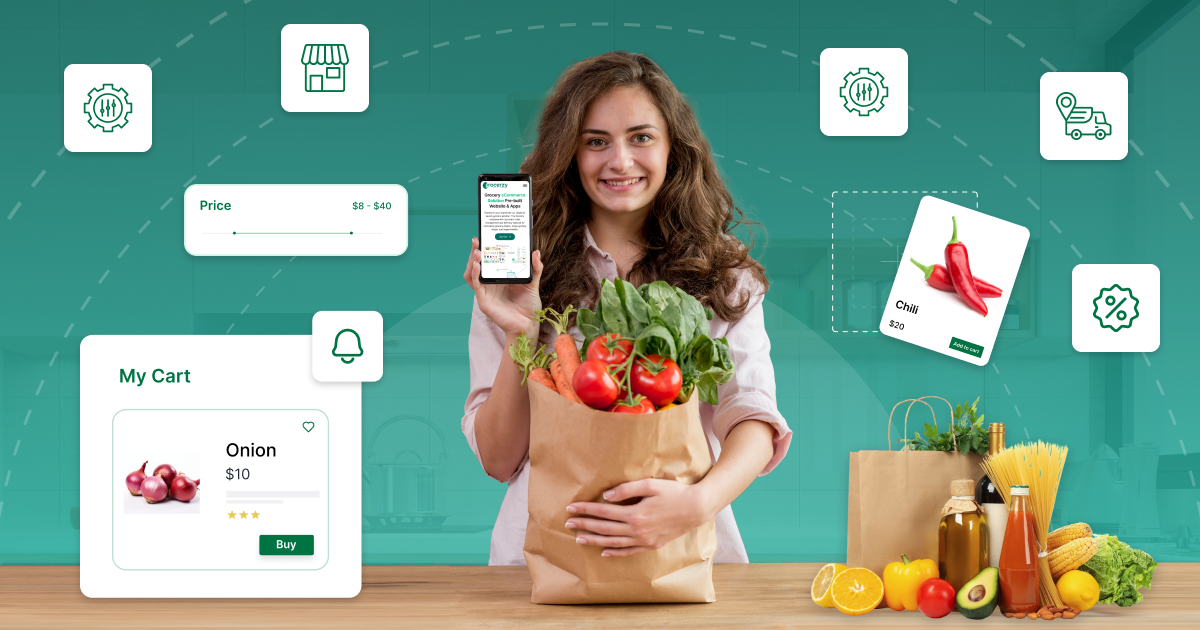How Mobile eCommerce in Grocery Is Reshaping the Industry?

Mobile commerce in the grocery industry is no longer a futuristic idea, it’s a central force transforming how consumers shop, how grocers deliver, and how brands like Grocerzy design their products and services.
From digital grocery solution to grocery eCommerce mobile app, every touchpoint is being reimagined around convenience, speed, personalization, and seamless integration.
In this article, we explore the trends, the challenges, and how companies can embrace mobile eCommerce in grocery to stay competitive especially if they offer both pre‑built and customizable options like Grocery.
The Rising Tide: Why Mobile eCommerce in Grocery Is Growing
First, let’s look at some compelling numbers that underscore why mobile commerce in grocery isn’t just growing — it’s accelerating:
- The quick commerce market is expected to reach revenue of about US$198.06 billion in 2025, with a CAGR of ~7.7% from 2025‑2030.
- Mobile commerce should represent around 59% of all online retail sales worldwide in 2025.
These numbers indicate that shoppers are becoming more accustomed to using mobile devices to buy perishables, daily essentials, and everything else. Grocery eCommerce mobile application use, coupled with digital grocery solutions, is now a common expectation rather than a novelty.
Key Trends Driving Mobile Commerce in Grocery
1. Instant & Quick Commerce
Quick commerce (or “q‑commerce”) refers to major growth in orders delivered in very short time windows (e.g. under 1 hour, often in 10‑30 minutes). This trend is pushing grocery eCommerce mobile apps to streamline logistics, keep dark stores or micro‑hubs near consumers, and tightly integrate inventory, fulfilment, and delivery.
For Grocery, it is increasingly non-negotiable to support Fast Delivery, Real-Time Inventory and On-Demand Order Tracking, whether you are a grocery store offering a pre-built solution or a customizable mobile app solution.
2. Mobile First, App vs Web
Consumers tend to prefer grocery store mobile app experiences over mobile web because apps can provide saved preferences, push notifications, quicker interfaces, and better personalization. According to recent stats:
- Mobile apps prove to deliver higher conversion rates than mobile websites.
- People browsing via apps tend to view more products per session, which increases average order value.
Thus, grocery mobile app development (and optimization of those apps) becomes a priority. A grocery store mobile app developed well can outperform a simple ecommerce website by bridging user convenience, UX design, and performance.
3. Omnichannel & Digital Grocery Solutions
Shoppers expect a seamless experience between offline and online: checking stock in‑store via mobile, placing orders via app for home delivery or pickup, using digital coupons, loyalty rewards, etc.
According to one study, 68% of shoppers use digital coupons or loyalty programs via mobile apps. Also, 45% use mobile apps for price comparisons.
These are elements of the broader digital grocery solutions ecosystem: combining mobile apps, ecommerce websites, in‑store tech, backend supply chain, and customer support to deliver smooth, integrated experiences.
Shoppers expect that. They also expect a mobile app solution for grocery stores to remember past orders, suggest favourites, offer personalised deals, or even plan reorder lists automatically.
What “Grocerzy” Brand Can Do: Pre‑Built vs Customizable Options
Given these trends, how should a brand like Grocerzy structure its offerings (pre‑built vs customizable) to deliver a strong grocery eCommerce mobile app and digital grocery solutions?
- Pre‑Built Solutions
- Pre‑built grocery app solutions have advantages:
- Faster time‑to‑market. Because many features (catalogue, cart, checkout, delivery tracking) are already developed.
- Lower initial cost. Without needing to build everything from scratch.
- Well‑tested core functionality. Less risk of bugs in basic features.
- Templates or frameworks that can cover many standard grocery store ecommerce website needs: inventory, order management, payment integration, promotional tools.
- Customizable Solutions
On the other side, a fully customizable grocery mobile app development approach allows:
- Unique branding, differentiated UX/UI, specific features (e.g. local language, special delivery models, integration with third‑party logistics, hyper‑local supply chains).
- Customized workflows
- Improved integration with current tech stacks
- Ability to scale and pivot as consumer habits change
For Grocery, offering both pre‑built and customizable options allows serving both smaller grocery stores that need speed and cost effectiveness, and larger operations or chain stores which need bespoke features.
Practical Components of a Strong Grocery eCommerce Mobile App
When Grocery designs or helps design a grocery store mobile app, there are several must‑have features and focus areas to ensure success with mobile commerce in grocery:
- Real‑time inventory visibility: Avoid disappointed customers; reduce cancellations; track stock across warehouses/dark stores.
- Fast & flexible delivery/pick‑up options: Quick commerce expectations; in‑app scheduling helps conversion.
- Personalisation & recommendations: Drives increased order size, customer loyalty.
- Seamless payment & wallet integrations: Mobile commerce rising only if payment friction is low.
Challenges to Address
While mobile commerce in grocery offers huge opportunities, there are significant challenges that Grocery must anticipate when building digital grocery solutions, pre‑built or custom:
- Logistics & fulfilment complexity:
Freshness, perishables, last‑mile delivery, dark stores, cold chains – all add cost and complexity.
- Inventory management across channels:
Keeping stock levels accurate across several fulfilment points (store, dark store, warehouse) and between in‑app and in‑store shopping.
- App performance & reliability:
Slow mobile apps having crash or buggy UX will lose customers quickly.
- Data privacy & security:
As apps collect more personalised data, ensuring compliance, security, trust is critical.
- Competition & margin pressure:
Quick‑commerce players often absorb thin margins to deliver speed. That can squeeze profitability.
- Customer expectations:
Free delivery, ultra‑fast delivery, always‑fresh produce — high expectations can be expensive to meet.
Case Examples & Facts
- Quick commerce platforms in Saudi Arabia, like Nana operate via mobile applications that promise delivery in around 10 minutes.
- As per surveys, globally, 72% of grocery consumers have utilized the service of online grocery home delivery.
- Customers desire groceries delivered or picked up as soon as possible, even as quickly as in 2 hours.
These facts show what features customers are looking for and what grocery store ecommerce website and mobile app solution is already giving them.
Given the shifts, a brand like Grocerzy (product‑based, offering both pre‑built and customizable options) has unique potential to lead in this space. Here’s how:
Positioning & Product Strategy
Market Grocery’s pre‑built solutions to small and medium grocery stores, neighbourhood grocers, or those entering digital commerce for the first time. Emphasize fast deployment, standard best practices, cost effectiveness.
Market Grocery’s customizable solutions to larger retailers, chains, or those with special workflows: vintage products, specialty goods, regional produce, B2B orders, subscription models.
Building for Scalability & Adaptability
To stay relevant in mobile commerce in grocery, apps built by Grocery should be modular: allow plug‑in features (e.g. subscription service, freshness tracking, loyalty).
Provide flexibility for UI themes, localization, and regional payment options.
Ensure backend supports multiple types of inventory fulfilment: dark stores, local stores, and warehouses.
Supporting Services & Maintenance
- Updates as well as fixes bugs along with UX enhancements and analytics dashboard.
- Offer payment gateways, logistic partners, loyalty programs and inventory systems.
- Consider customer feedback via mobile app, surveys and usage data.
- Differentiation Through Value & Trust.
- Also emphasizing trust: secure payments, data privacy, policy clarity, and customer service.
Predictions: Where It’s Headed
Looking ahead, these are some directions mobile commerce in grocery is likely to evolve, which Grocery and similar firms should watch or integrate:
- Ultra‑fast delivery & predictive stocking: Using AI to anticipate demand in certain localities, stocking dark stores or micro‑depots accordingly.
- Voice & visual search: Voice instructions and scanning images/ barcodes along with taking photos of items to reorder.
- Subscription & auto‑reorder models: For staples and recurring items.
- Sustainability & local sourcing: Customers increasingly prefer local produce, less packaging; apps that allow filtering by “local”, “organic”, “eco‑friendly” can give competitive edge.
- More integration between online/offline channels: Click & collect; in‑store pickup, mobile check‑in; scanning QR codes in‑store to add to cart for later delivery.
How Mobile eCommerce in Grocery Business Work Best
To wrap up, here are actionable recommendations for Grocery to ensure its pre‑built and customizable product lines deliver best-in-class mobile commerce in the grocery sector
- Focus on UX from Day One
- Easy search/navigation, minimal friction at checkout, fast loading times, clean design.
- Let customers reorder from past orders, save lists.
- Ensure flexible fulfilment & logistics
- Integrate with multiple delivery partners.
- Support same‑day/within hours delivery.
- Real‑time inventory updates to avoid unpleasant surprises.
- Invest in strong analytics & data collection
- Track what users search for, abandon carts, reorder frequency.
- Use that data to personalise offers.
- Offer modular/customizable features
For example, modules for loyalty programs, subscription, region‑specific payments, etc.
Allowing customers to enable/ disable these or even customise.
- Put security, compliance and privacy at first.
- Practice regular checks following local laws about data protection.
- Continuous iteration & support
- Release updates that improve performance.
- Gather user feedback.
- Monitor app crash rates; improve first‑time experience.
- Marketing & customer acquisition
- Use app store optimization, push notifications, referral programs.
- Use targeted promos or coupons via grocery eCommerce mobile app.
- Showcase convenience, reliability, speed.
Conclusion
Mobile grocery commerce has gone from also-ran status to must-do status. With evolving customer expectations, new technology, growing penetration of smartphones, and the success of quick-commerce, any grocery that fails to climb aboard risks falling further behind.
Grocery has considerable opportunity to serve several market segments, including new small operators on the initial stages of their digital transformation, to large chains interested in custom and sophisticated grocery mobile app development.
Grocerzy will be in a significant position to help reinvent grocery shopping in the mobile paradigm through Readymade Grocery Delivery App that create more seamless UX, allow for rapid delivery, offer dependable performance and are flexible.
Partner with our experts for better outcomes.



